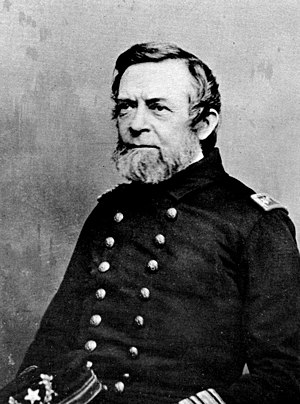 Image of Andrew Foote via Wikipedia
Image of Andrew Foote via WikipediaOn Thursday, September 5, 1861, Captain Andrew Foote arrived in St. Louis to take command of the Federal naval forces on the upper Mississippi. Foote superseded Commander John Rodgers. Foote would later work closely with General Ulysses S. Grant in combined army/navy operations on the Tennessee and Cumberland Rivers.
Foote briefly attended West Point in 1822, but left to accept an appointment as a midshipman at Annapolis. He had a reputation as a fighter. During the Second Opium War, in the Battle of the Pearl River Forts in Canton, China, in 1856, Foote led a landing party of 287 men. They captured one fort and used the captured guns to attack and capture another fort. Then, with the help of the blockading ships, they fought off a counterattack by some 3000 Chinese soldiers and captured two more Pearl River forts.
Rodgers would head east to serve under Flag Officer Samuel Du Pont in the Port Royal Expedition in October. He would served in the U.S. Navy until his death in May 1882. At that time he was the Navy's oldest active rear admiral.
Also on this date, President Abraham Lincoln met with General Winfield Scott. The main topic of conversation was what to do about John Frémont, the commander of the Department of the West, who was becoming more of a headache for the administration with each passing day.
At Cairo, Illinois, General Ulysses S. Grant was looking to counter the Confederate position at Columbus, Kentucky. He recognized the important of Paducah, at the confluence of the Ohio and Tennessee Rivers, and formed an expedition to occupy the town. The troops left that evening. Grant informed Frémont of his intentions, but had the troops in motion before receiving a reply.

No comments:
Post a Comment